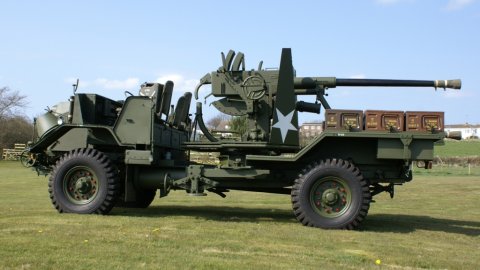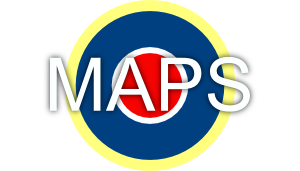Patrons:
Air Marshal Sir Ian Macfadyen
The Lieutenant Governor, His Excellency Lieutenant General Sir John Lorimer KCB DSO MBE
The Morris-Commercial C9/B Self-propelled Bofors gun

In March 2010 the museum put its Morris-Commercial C9/B Self-propelled Bofors gun on display.
This is an extremely rare surviving example of a vehicle that entered service with the Manx Regiment in the early months of 1944 in preparation for the invasion of Europe. At that time just one Troop of each of the Regiment's three Batteries was issued with self-propelled Bofors guns to replace the towed guns which had been used previously. At the time of the invasion, all the SP Troops were gathered into a composite Battery and it was not until early 1945 that the Regiment became fully equipped with self-propelled guns.
The Morris C9/B Self-propelled Bofors was developed as a private enterprise by the Morris-Commercial company using a lengthened version of the well-known C8 “Quad” artillery tractor. A very basic body was installed, providing four-abreast seating for the driver and three of the crew, with no cab and only the very earliest vehicles having a windshield. A cab would have prevented the gun from having a 360 degree traverse; even the steering wheel was hinged so that it could be folded out of the gun barrel’s way. The gun itself was mounted on a slightly modified Bofors mounting in the mid part of the chassis, with flat platforms behind it upon which ammunition boxes could be stowed. Tools and the crew’s kit were housed in several stowage boxes slung underneath various parts of the vehicle and the whole ungainly outfit was rounded off by having four very hefty scissor-type jacks at the front, rear and both sides to raise the vehicle off its wheels and provide a stable firing platform.
1680 C9/Bs were made and very few survive. In 2005 we began searching for one which would be suitable for exhibition at the museum and we very quickly found how rare they were. Most had been fitted with cranes or other specialist gear upon demob and their Spartan original bodywork was more often than not discarded. Three restored vehicles were located in museums, and until an advertisement appeared on a military vehicles website in mid-2008 we had almost decided that those three were all that were left. A phone call to the seller resulted in a number of photographs being received and a deal was struck. The Morris was shipped to its new home on the Isle of Man in September 2008.
Many people and organisations were contacted in a search for information and manuals. The amount of help that was received was phenomenal. A copy of the workshop manual was supplied by Brian Baxter of the REME Museum of Technology and a fellow C9/B owner provided us with a copy of the Army key card relating to the vehicle. These cards provide details of the vehicle’s serial number, date of demob and sometimes details of their last unit. The survival of key cards for different vehicle types is rather hit and miss so it was a great relief to find that the truck’s card was still at the Tank Museum at Bovington – although the Museum’s staff didn’t seem to be aware of it! We had no idea what our truck’s Army number had been as it is not stamped onto the vehicle but only painted onto the bodywork, so finding its original number was a real breakthrough.
The truck had been the subject of a mighty reconstruction in the 1990s by its former owner.



After being demobbed in the 1950s it had been used as a recovery truck and his dedication in searching out original parts and fittings is a credit to him, as is the standard of his workmanship in refabricating much of the sheet metalwork. It is almost certain that it would be impossible to do a similar restoration today as most of the scrapyards which provided parts have long since been cleared.
Compared to the original feat of restoration our efforts were puny, consisting mainly of replacing a few inaccurate details, a few minor repairs and a repaint. Restorer Ivor Ramsden tells the story of what was done to the truck:
The previous owner had warned me that the brakes were seized, the starter was faulty and there was a water leak from the engine. Although this was my first rebuild of a military or commercial vehicle I have been restoring early Land-Rovers for 30 years so when a few other minor faults became apparent there was nothing too daunting. My first predicament was how was I going to support the heavy vehicle whilst the axles were stripped? Luckily, before I rushed out to buy new heavy-duty stands, I remembered that it came with its own jacks. After standing it on its jacks I removed the wheels – they were much heavier than Land-Rover ones and that goes for every part of the Morris. I even remembered that the left-hand wheel nuts were left-hand thread. The truck’s new home is close to the sea so even though we will be dehumidifying its display area I decided that all the brake cylinders should be rebuilt with stainless sleeves and the system refilled with silicon brake fluid in order to prevent water absorption and corrosion. The finished system works effectively but in its own time, and I have to say that driving the truck is enjoyable despite requiring much more operator input and anticipation than I am used to.
I thought that the inaccessibility of parts under the bonnets of vehicles was a modern phenomenon until I came to take the Morris’s starter motor off. It is IMPOSSIBLE to get to all of the mounting bolts from under the bonnet and to access them from inside what passes for a cab you have to be double-jointed and young, flexible and fit, none of which I can claim to be. I eventually had to remove the driver’s seat and lie with my face down amongst the pedals and my feet in the air whilst turning the top bolt one flat at a time. What joy! Whilst the seat was out I fitted a modified Land-Rover slider mechanism to it to make it adjustable because, despite being nearly 6 foot, I could only operate the pedals whilst teetering on the edge of the seat.
The engine’s water leak which I had been warned about appeared to be coming either from the head gasket or the top of the water jacket side cover. I thought that it would be wise to remove the head to check the valves and the bores even though I had seen photos taken during the original restoration which showed that the head had been off. Careful use of wooden wedges lifted the head and revealed that at the top of the water jacket on one side of the block there is only a very narrow section of metal for the gasket to seal onto. It was this area which was the source of the leak so it was carefully cleaned up and a new gasket installed. Removal of the water jacket’s side cover plate uncovered a horrible mass of brown sludge so the water jacket was thoroughly hosed out whilst everything was accessible. A couple of stripped threads in the block were the cause of a leak from the water pump flange so these were drilled out and thread replacements were inserted. The repairs have been effective and the system now works as it should.
I overhauled the fuel system, which on the C9/B has a unique feature in that the carburettor can be fed via the float chamber as normal, or via a more direct feed to prevent any problems with interruption of fuel supply caused by vibration whilst the gun is firing. (The disruptive effect of firing 120 40mm rounds per minute on the level of fuel in the float chamber is not too difficult to imagine). The need for the engine to be kept running whilst firing was because originally these vehicles were supplied with a large generator to supply power for electrical control of the gun in conjunction with a remote predictor system but this system was soon replaced by direct human control which was much preferred by the Gunners themselves.
Modern lights had been built into the truck and I wanted it to be displayed in its 1944 condition so these were removed. Originally the only lights on the back were a single tail lamp and a convoy light; there was no stop light at all. This system has been authentically replicated but modern lighting requirements are also met with two easily-removable self-contained units which are each fixed by a single wing-nut and hidden multi-plug. The front indicators are hinged so as to fold out of sight behind the bumper.
No trace of the original paint could be found so I had to ponder long and hard whether to repaint the truck in the brown and black “Mickey Mouse Ear” camouflage of 1943 and early 1944 or in Olive Drab which was introduced in Spring 1944. I chose the later single colour which is livened up no end by the many different markings which adorn most wartime vehicles. I hand painted the 7th Armoured Division’s “Desert Rat” symbol which in this case has an unfortunate resemblance to a kangaroo, but it is an accurate copy of a period example. Stencils were used for the other markings - the Allied stars, serial numbers and markings for the ammunition boxes. The eagle-eyed will note that the Allied stars on the gun shield are upside-down and again this is copied from our only clear period photo of a Manx Regiment C9/B. I think the reason for the inverted stars is that, due to the gun shield narrowing from bottom to top, the stencil size used back in 1944 would only fit upside down!
After three months’ hectic work the Morris was essentially finished and work started on building a new Nissen hut in which to house it.

The truck is presently only fitted with its standard equipment, ammunition boxes etc. Period photographs invariably show these vehicles well laden with various items of personal kit, camouflage nets and tarpaulins so I shall be attempting to replicate this lived-in appearance in due course.
The Society is very grateful to the Manx Lottery Trust for funding the purchase of the Morris and to the Manx Heritage Foundation and the Gough Ritchie Charitable Trust who contributed towards the cost of its restoration and the building of a Nissen hut in which to display the vehicle.
